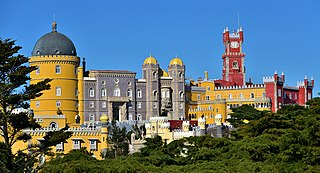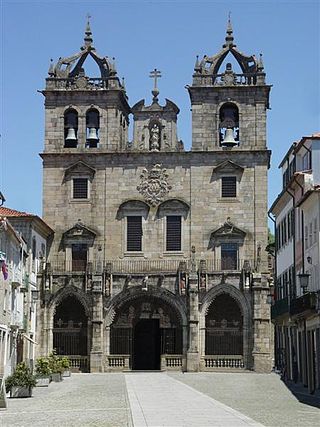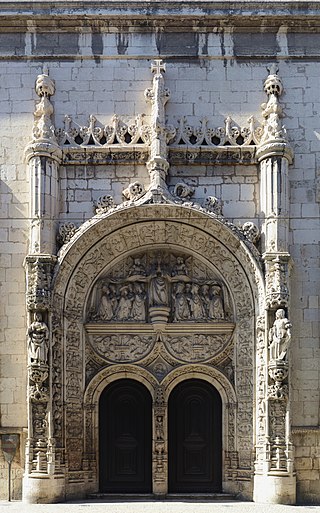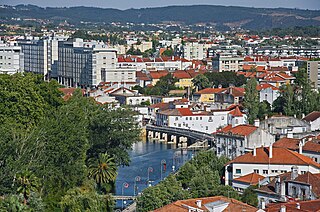
The Pena Palace is a Romanticist castle in São Pedro de Penaferrim, in the municipality of Sintra, on the Portuguese Riviera. The castle stands on the top of a hill in the Sintra Mountains above the town of Sintra, and on a clear day it can be easily seen from Lisbon and much of its metropolitan area. It is a national monument and constitutes one of the major expressions of 19th-century Romanticism in the world. The palace is a UNESCO World Heritage Site and one of the Seven Wonders of Portugal. It is also used for state occasions by the President of the Portuguese Republic and other government officials.

The Manueline, occasionally known as Portuguese late Gothic, is the sumptuous, composite Portuguese architectural style originating in the 16th century, during the Portuguese Renaissance and Age of Discoveries. Manueline architecture incorporates maritime elements and representations of the discoveries brought from the voyages of Vasco da Gama and Pedro Álvares Cabral. This innovative style synthesizes aspects of Late Gothic Flamboyant architecture with original motifs and influences of the Plateresque, Mudéjar, Italian, and Flemish architecture. It marks the transition from Late Gothic to Renaissance. The construction of churches and monasteries in Manueline was largely financed by proceeds of the lucrative spice trade with Africa and India.

The Jerónimos Monastery or Hieronymites Monastery is a former monastery of the Order of Saint Jerome near the Tagus river in the parish of Belém, in the Lisbon Municipality, Portugal. It became the necropolis of the Portuguese royal dynasty of Aviz in the 16th century but was secularized on 28 December 1833 by state decree and its ownership transferred to the charitable institution, Real Casa Pia de Lisboa.

The Military Order of Christ is the former order of Knights Templar as it was reconstituted in Portugal. Before 1910, it was known as the Royal Military Order of Our Lord Jesus Christ, and the Order of the Knights of Our Lord Jesus Christ. It was founded in 1319, with the protection of King Denis of Portugal, after the Templars were abolished on 22 March 1312 by the papal bull, Vox in excelso, issued by Pope Clement V. King Denis refused to pursue and persecute the former knights as had occurred in most of the other sovereign states under the political influence of the Catholic Church.

The Monastery of Batalha is a Dominican convent in the municipality of Batalha, in the district of Leiria, in the Centro Region of Portugal. Originally, and officially, known as the Monastery of Saint Mary of the Victory, it was erected in commemoration of the 1385 Battle of Aljubarrota and would serve as the burial church of the 15th-century Aviz dynasty of Portuguese royalty. It is one of the best and original examples of Late Flamboyant Gothic architecture in Portugal, intermingled with the Manueline style.

The Cathedral of Évora is a Roman Catholic church in the city of Évora, Portugal. It is one of the oldest and most important local monuments, lying on the highest spot of the city. It is part of the historical city centre, and the seat of the Archdiocese of Evora.

The Cathedral of Braga is a Roman Catholic church in the northern city of Braga, Portugal. Due to its long history and artistic significance, it is also one of the most important buildings in the country. It is the seat of the Archdiocese of Braga and of the Primate Archbishop of Portugal and Spain.

The Church of Santa Maria do Olival is a Roman Catholic church in the city of Tomar, in Portugal. The Church has been characterized as National Monument since 1910.

The Alcobaça Monastery or Alcobasa Monastery is a Catholic monastic complex located in the town of Alcobaça, in central Portugal, 120 km (75 mi) north of Lisbon and 110 km (68 mi) south of Coimbra.

The Monastery of Jesus is a historical religious building in Setúbal, Portugal, which served a monastery of Poor Clare nuns. It is one of the first buildings in the Manueline style, the Portuguese version of late Gothic. The cloisters of the complex houses a museum of the monastery. In 2013, pan-European heritage organization Europa Nostra declared the monastery to be one of the 7 most endangered monuments in Europe.

The Church of Nossa Senhora da Conceição is a church in the civil parish of Madalena, in the municipality of Lisbon.

Diogo de Arruda was a noted Portuguese architect that was active during the early years of the 16th century. He had some other important family members including his brother, Francisco de Arruda and his nephew, Miguel de Arruda.

Portuguese architecture refers to both the architecture of Portugal's modern-day territory in Continental Portugal, the Azores and Madeira, as well as the architectural heritage/patrimony of Portuguese architects and styles throughout the world, particularly in countries formerly part of the Portuguese Empire.

Portuguese Gothic architecture is the architectural style prevalent in Portugal in the Late Middle Ages. As in other parts of Europe, Gothic style slowly replaced Romanesque architecture in the period between the late 12th and the 13th century. Between the late 15th and early 16th century, Gothic was replaced by Renaissance architecture through an intermediate style called Manueline.
The architecture of the Portuguese Renaissance intimately linked to Gothic architecture and gradual in its classical elements. The Manueline style was a transitional style that combined Renaissance and Gothic ornamental elements to buildings that were architectonically closer to Gothic architecture, as is the Isabelline style of Spain. Manueline was succeeded by a brief Early Renaissance phase, closer to Classical canons, followed by the adoption of Mannerist forms. Portuguese Mannerism, specially in secular architecture, is characterised by simplicity in the organisation of façades and relative lack of decoration, being often referred to as Estilo Chão. Even with the arrival of Baroque architecture in the late 17th century, Portuguese architecture continued to use Mannerist forms well into the 18th century.

The Monastery of Saint Denis is located in the city of Odivelas, near Lisbon, in Portugal. The feminine Cistercian convent was founded by King Dinis I and was built during the 14th century in Gothic style. It is the burial place of the king. From 1900 to 2015, it housed the Instituto de Odivelas, an internal college for girls.

Tomar, also known in English as Thomar, is a city and a municipality in the Santarém district of Portugal. The town proper has a population of about 20,000. The municipality population in 2011 was 40,677, in an area of 351.20 km2 (135.60 sq mi).

The Hermitage of Nossa Senhora da Conceição is a 16th-century hermitage located in the civil parish of São João Baptista, in the municipality of Tomar, designated as a National Monument in 1910.

The Military Order of Christ was founded in 1318. The order, in every sense of the term, were Knights Templar who continued their operations from their headquarters in Tomar, Santarém Portugal. Contrary to the belief that the Templar Order was renamed and established by King Denis of Portugal, the Templars merely moved backed to their original headquarters in Tomar Castle which was an autonomous zone granted to the Templar Order. Reasons for this move and change of name were to protect the vast assets of the order from repatriation by the Catholic Church. The Templar assets were then transferred over to the Cavaleiros de Cristo, all with the blessing of King Diniz who helped pull off the deal with the Church.

The Romanesque style of architecture was introduced in Portugal between the end of the 11th and the beginning of the 12th century. In general, Portuguese cathedrals have a heavy, fortress-like appearance, with crenellations and few decorative elements apart from portals and windows. Portuguese Romanesque cathedrals were later extensively modified, among others the Old Cathedral of Coimbra, although it only had some minor changes.






























